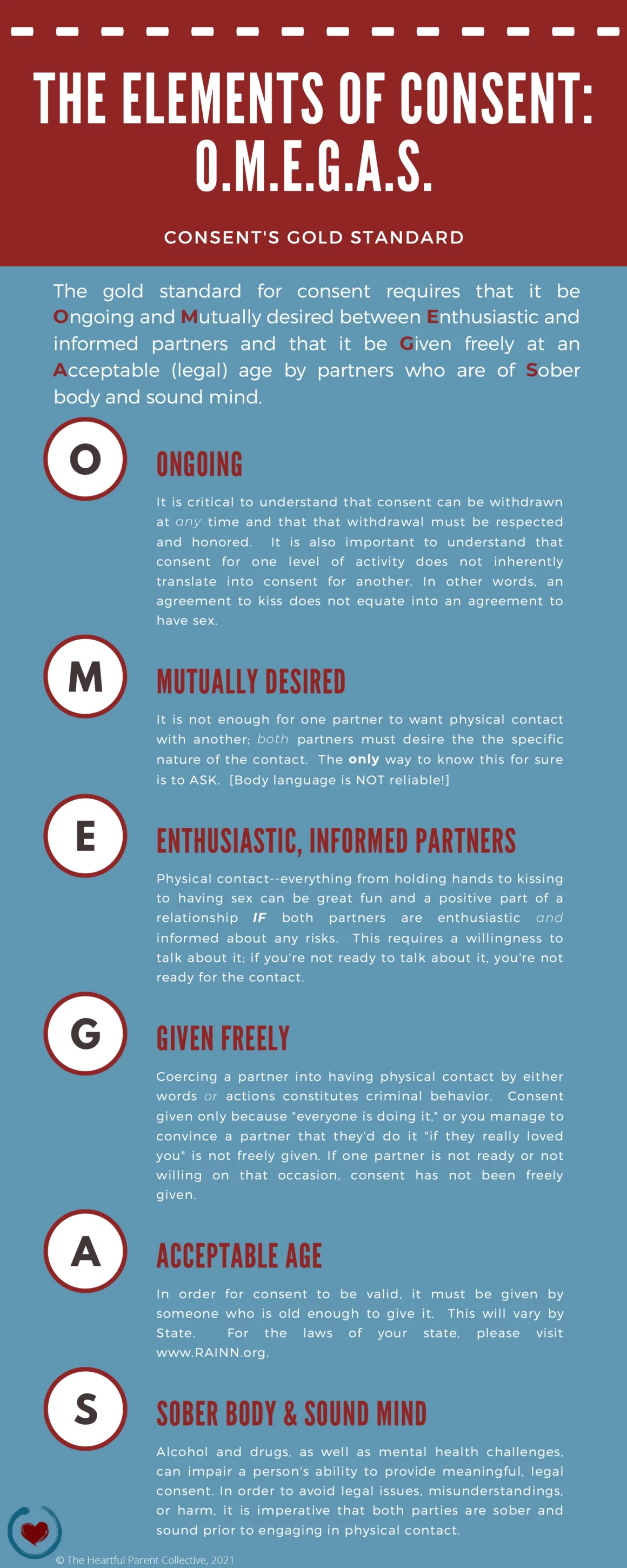Preteens and teens are bombarded with conflicting messages about sexuality, masculinity, femininity, and relationships. They may hear that consent and body boundaries in relationships are important, but are surrounded with examples in pop culture, media, and pornography where consent is, at best, never asked for, and at worst, violently ignored.
Research shows that caregivers, who are often unsure themselves about what consent means and may be uncomfortable talking about sex, are neglecting these conversations altogether in alarming numbers.
Unfortunately, when parents or caregivers don’t talk about consent and relationships, they miss out on the opportunity to not only convey their values and expectations, but also the chance to teach the real-life skills they need to navigate the often confusing world of sexuality and adulthood.
Ideally, talking with preteens and teens follow on the heels of years of conversations when they were younger about their bodies, body boundaries, and body safety. However, whether you as a caregiver have had conversations on consent and body boundaries often, or are just diving in, here is what the preteens and teens in your life need to know to keep themselves — and their partners — safe, happy, and healthy.
What Are Body Boundaries?
Body boundaries are the invisible space around your body. You have a personal set of rules of when you feel comfortable with someone crossing that boundary, say a high five or hand shake, and when you do not feel comfortable with someone crossing that boundary.
As early as possible, caregivers should begin laying the foundation for children around body boundaries, personal safety, and personal body rights. These conversations should promote the fundamental idea that every child has the power and the right to decide what is done to their bodies, when, and by whom — no matter what.
By empowering children with information and safety tools, caregivers keep the lines of communication open, and help young people better practice safety rules. Armed with this information from a young age, children are more likely to grow into a preteen and teen who understand and are receptive to the concept of consent, because they have internalized the core idea that each person is the boss of, and has the right to make decisions about, their own body.
For more information on how to engage younger children in these conversations and what they need to know, please visit the resources at Savvy Parents Safe Kids.

What Is Consent?
At its core, consent is an agreement between people to engage in some form of touching — from holding hands to sexual intercourse.
When one person claims that another acted or did something sexual to their body without consent, the law usually requires that the victim establish they said “no” in some way or were incapable of giving consent for some reason. This puts the burden on the person being touched rather than the person doing the touching.
Teaching consent is important because it not only teaches your children to respect other people’s boundaries and choices, but it also will let them grow confident in their voice and be confident of their choices as they explore relationships.
Teens Deserve Better Regarding Learning About Consent
Sex and other physical touching can be a fulfilling part of a healthy relationship, and safe, fun sex between consenting partners should be the gold standard for all adolescents as they grow into adulthood and make decisions to be sexual. To realize that, however, they need a better definition for consent than the one the law provides, or than is demonstrated in pop culture.
To make it easy for children and teens to learn, and to make it easier to focus on whether there is a “YES” rather than the absence of a “no,” the OMEGAS of Consent© can be really helpful. These guides give teens and preteens a better framework upon which to construct their relationships through a deeper understanding of consent and respect for body boundaries.

O: Consent Must be ONGOING
It is critical that preteens and teens know that consent can be given and withdrawn at any time, and that withdrawal of consent, whenever it comes, must be respected and honored.
It is also important for preteens and teens to understand that consent for one level of activity does not necessarily translate into consent for another. For example, an agreement to kiss does not equate into an agreement to have sex.
M: The Activity Must Be MUTUALLY DESIRED
It is not enough for one partner to want physical contact with another — both partners must desire both the contact and the specific nature of that contact. Preteens and teens need to understand that body language is inherently unreliable and that the only way to know for sure whether a partner is okay with what is happening is to ASK.
Help preteens and teens understand that asking not only demonstrates and cultivates respect, it may also cultivate deep connections between two people. After all, what is more appealing and connecting than feeling like your wishes, desires, and opinions matter?
E: It Must be Between ENTHUSIASTIC AND INFORMED PARTNERS
It may be hard for caregivers to think about their preteen or teen as a sexual person, but it’s important for them to hear from trusted, loving adults that sex can be amazing IF — and only IF — both partners want it. When someone is both self-respecting and empathetic enough to wait until they find a partner who not just says “yes” but does so enthusiastically, they will realize it was worth the wait.
This also means caregivers need to encourage young people to have conversations with their partners and to teach preteens and teens that if they’re not ready to talk about it, they’re not ready to do it. Both partners deserve to know what the expectations and risks are before they dive into intimate contact.
G: It Must be GIVEN FREELY
Coercing or pressuring a partner into having physical contact by words or actions — whether it’s the first time or 500th time — is criminal. Consent given only because “everyone is doing it” or because one partner manages to convince the other that they need to have sex to show their love, is not freely given. If one partner is not ready or willing on that occasion, consent has not been freely given.
A: Both Parties Must be of an ACCEPTABLE AGE
In order for consent to be valid, it must be given by someone who is old enough to give it. This will vary by state. Depending on the state or jurisdiction, the relative age of the partners may matter more than the number itself.
For example, two 14 year olds may be allowed to consent to sexual contact, but a 14 year old likely cannot consent to contact with a 19 year old. Again, visit RAINN.org for more information.
S: Both Partners Need to be of SOBER BODY & SOUND MIND
Alcohol, drugs, and even mental health challenges can impair a person’s ability to provide meaningful, legal consent. It may seem obvious to most adults, but a person who is highly intoxicated or unconscious cannot give consent, and caregivers need to be telling their preteens and teens this. People in an impaired condition are in need of protection not penetration.
Teaching teens to tune into their empathy when they see someone in this state and protect their friends from being harmed or harming anyone is important.
Teaching Consent and Body Boundaries
Talking about sex and relationships with your preteen or teen may feel awkward, but it is very important that you talk early and often, and teach them about consent and body boundaries. Talking about body boundaries can start from as young as three years old, and grow in understanding and knowledge as your child grows. Learn more about how to approach conversations about consent and body boundaries with your child here.
